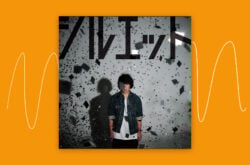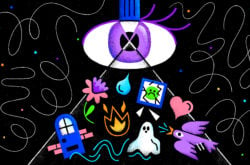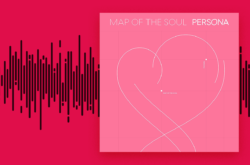End of the World is forging a path that few others have attempted to navigate.
The four-piece band consisting of members Fukase (vocals), Saori (piano), Nakajin (guitar), and DJ Love (DJ) began their collaboration over a decade ago, performing in a self-built venue in Tokyo with 15 people in attendance. Since, they have grown to become one of Japan’s indisputably largest acts as SEKAI NO OWARI, selling millions of albums and touring across the largest venues in Asia.
End of the World (an English translation of the phrase “sekai no owari”) is a separate project the members set in motion in recent years to channel their keen desire to connect with a global audience. A completely reimagined alter ego to SEKAI NO OWARI, End of the World release all-new songs written entirely in English, and their debut album Chameleon features a diverse range of collaborators including Clean Bandit, DNCE, and NIKI.
This endeavor positions End of the World as an unparalleled trailblazer from the systematically inward-looking Japanese music industry, as very few popular acts have made a concerted effort to venture beyond the country—let alone establish an entirely separate project in order to achieve that goal.
In celebration of the recent release of the deluxe edition of Chameleon (alongside their all-new SEKAI NO OWARI album scent of memory), we had the privilege of sitting down with the group to dive deeper into the beginnings of End of the World, how they approach their creative process across projects, future aspirations, and more.
Our original discussion with End of the World was conducted in Japanese; responses quoted below are English translations.
A desire to connect
Expanding on the initial spark that led to the creation of End of the World, Fukase tells us, “As we were granted with more opportunities to express ourselves as SEKAI NO OWARI overseas, we saw just how few people knew Japanese, and felt that there was so much we couldn’t communicate because of this. We believed English was necessary if we wanted to bring our music to more countries, but if SEKAI NO OWARI started releasing more and more English songs, our existing fans would inevitably get confused. So, we established End of the World to create something entirely different for the world.”
Language isn’t the sole aspect where the two projects differ—the timbres, song structure, and melodies in each discography thoughtfully reflect what resonates with their respective audiences. “Japan’s musical landscape is just so specific,” Nakajin explains. “When you look at things like Shazam rankings, it’s clear that there’s a level of consistency across other countries, but Japan’s charts are often pretty distinct from the rest—the way people enjoy music is quite different, and the culture is different. So, we shift perspectives and approaches often with the two projects. We’re frequently working on music as both SEKAI NO OWARI and End of the World simultaneously, and mentally going back and forth between the two can be quite the unique challenge.”
“Dropout Boulevard” / “Dropout”
Despite the fact that there are significant differences between the two worlds they navigate, that isn’t to say there’s no common ground. The track “Dropout,” a single on scent of memory, was also featured on Chameleon as “Dropout Boulevard.” While the core song is the same, the arrangement differs quite drastically across the two albums; the track serves as a fascinating example of how the group meticulously reimagines their sound for each project.
“It was essentially a track we originally wrote for End of the World, but ended up debuting in Japan,” Fukase shares. “This song communicates a message that’s very fundamental to me—it’s something that lies at my roots. There are phrases I suggested, and as we worked on them with a songwriter in English, I really fell in love with the lyrics. We want ‘Dropout’ to be heard across both Japanese and overseas listeners, as it represents a kind of self-introduction.”
「Dropout」は自分の自己紹介みたいな曲なので、日本・海外特に分けずに聴いてもらいたい。
We want “Dropout” to be heard across both Japanese and overseas listeners, as it represents a kind of self-introduction.
—Fukase
The band calls out “Stargazer Reimagined” as one other track that also appears on both Chameleon and a past SEKAI NO OWARI release:
Exploring new ways of making music
While End of the World’s unique sound comes in part from their intentional recognition of an international audience, a lot of it is also the organic result of an entirely different creative process. The members have each spent significant amounts of time working in American and European settings alongside local musicians, and this generated both new challenges and fresh sources of inspiration.
“Writing sessions in particular is a practice that isn’t popular in Japan,” Fukase notes. “I’m sure there are some people who do it, but it’s certainly not mainstream—we hadn’t encountered it previously. Whenever we’d go to karaoke in Japan and sing American or European songs, we used to always be surprised by how many people were credited for each track. But after coming overseas and working on music here, we finally realized this was due to writing sessions. In Japan, even when there are four people in a band, many groups have the vocalist do all of the songwriting, composition, and arrangement. The contrasting approach of making music with these sorts of ‘teams’ is something we experienced for the first time coming here.”
A change in environment
For Saori, a lot of musical ideas came from seeing new sights and engaging in new experiences. “The scenery we see here is completely unique from what we see back home,” she tells us. “I’ll gather these little ideas I’ve made from things I’ve encountered and send them to Nakajin, and he’ll develop them into bigger ideas like a chorus. Seeing different things from what I see in Japan results in the creation of entirely different music. Listening to American musicians, until now I always wondered what kinds of situations would result in the kinds of music they made. After living here, I now understand how seeing these sights would result in the output of certain kinds of music.”
日本で見てた景色じゃないものを見てるんで、出てくる音楽が全然違うんです。アメリカのミュージシャンの曲とかを聴いて、「どういう時にこんな曲を作るんだろう?」 って今まで不思議だったんですけど、こっちに住んでこういう景色を見ていたら、こういう音楽が出てくるかもっていうのが色々と良く分かります。
Seeing different things from what I see in Japan results in the creation of entirely different music. Listening to American musicians, until now I always wondered what kinds of situations would result in the kinds of music they made. After living here, I now understand how seeing these sights would result in the output of certain kinds of music.
—Saori
“Saori likes to express all of her different experiences using the piano,” Fukase laughs. “She speaks through it.”
Also an essayist and novelist, Saori gets creative sparks from her writing as well. “Sometimes, a phrase I wrote for a novel or a metaphor I came up with for an essay inspires some lyrics,” she says. “And of course, I also write about making music in my essays. Each passion pushes me to put in my best efforts for the other.”
An unwavering commitment to their music’s message
No matter how much they experiment with new sounds, creative processes, and influences, there’s one thing that End of the World refuse to compromise: their commitment to communicating messages that matter to them. This is absolutely a through line across their work—since their first releases as SEKAI NO OWARI, the band has exposed their audience to a wide array of topics through their music, whether it’s fantasy-like stories or keenly vulnerable themes like mental health and confronting loss.
It goes without saying that writing songs in an entirely new language presents an immense obstacle in relation to this endeavor. “Writing lyrics was our single greatest challenge,” Nakajin tells us. “The emphasis on rhyming in particular is something that typically doesn’t exist with making Japanese music. Seeing so much weight put on constructing lyrics that rhyme and flow well was a difference and difficulty we had to navigate.”
However, the band didn’t shy away from tackling this challenge head-on when crafting Chameleon. “Our lyrics and messages are the elements that are the most fundamental core to our music, more so than our sound,” Nakajin continues. “In sessions, if we felt that we wouldn’t typically sing a particular phrase or say particular words when speaking naturally, we would default to avoiding them. Even as we also placed an emphasis on rhyming, we would always pair that with making music that feels true to us. We often wouldn’t be able finish during sessions because of this. So, even after we returned to Japan, we’d be tenaciously going back and forth with writers via Zoom over and over again, until we found the truly right words—that was something that was important to us. There’s no point if our music doesn’t reflect our authentic selves and lives.”
日本に帰ってからもZoomでライターとやりとりを何回も何回もしながら、本当に正しい言葉が見つかるまで粘り強くやるっていうのは大事にしてます。僕ら自身の生き様が出てる音楽じゃないと意味がないので。
Even after we returned to Japan, we’d be tenaciously going back and forth with writers via Zoom over and over again, until we found the truly right words—that was something that was important to us. There’s no point if our music doesn’t reflect our authentic selves and lives.
—Nakajin
A sense of complete trust
If it isn’t abundantly clear by now, the lyrics aren’t something that Fukase crafts alone as the vocalist; the members all care about their songs’ messages deeply and play an active role in crafting them. There’s a feeling of intimacy and an even stronger feeling of trust that emanates from the band—and Fukase in particular—as they talk about this process.
“If I speak directly on my own lyrical ideas too much, things will often end up in a standstill because I get too fixated. This is usually where Saori and Nakajin will come in and tell me that Fukase wouldn’t say this line or that phrase—and I’ll yield to their understanding of me,” Fukase laughs, along with the others. “I often put things in their hands.”
What lies ahead for End of the World
With the deluxe edition of Chameleon now out in the world, the group has a number of new and exciting projects that they’re working on. “We have a few collaborative tracks coming up,” Fukase shares. “They’ll be totally different from what we made for Chameleon. That album was specifically about tackling all sorts of challenges—producers would tell us about what resonates in America, and we would make things in response and listen to them at home, wondering if it’s really ‘our music.’ So, we would try inserting more of ourselves, or our J-pop influences, and keep adjusting and contemplating. Changing colors depending on our environment and getting lost on what our true color is in the midst of that process—this was the motivation for naming the record ‘Chameleon.'”
It’ll be exciting to hear how End of the World continue to challenge, reimagine, and further define their musical color in future releases. They give us a taste of their latest creative explorations with the first of their new collaborative tracks, “Silver Lining,” which they released with Tokyo Machine just a few days ago—you can take a listen below:
A lifelong journey
Looking towards the bigger picture, End of the World have ambitious goals for both the project as a whole and themselves as a collection of creatives. “Our ultimate goal is to continue making music until the day we die,” Fukase states. “To be able to keep making music, put on shows, and have fans that come to these shows for the span of your entire life—there are almost no artists who are able to do that. I think it’s definitely rarer and more difficult than being an artist who performs at venues like The Forum or Tokyo Dome, but that’s the even higher bar that we strive to meet: making music until we die.”
死ぬまで音楽をずっと続けられて、そこにライブが出来て、ファンがいて——そんなことが出来てるアーティストって本当にいないんですよ。The Forumでやってるアーティストや東京ドームでやってるアーティストより絶対に少なくて絶対に難易度が高いから、僕らの目標は更に上で、「死ぬまでやること」です。
To be able to keep making music, put on shows, and have fans that come to these shows for the span of your entire life—there are almost no artists who are able to do that. I think it’s definitely rarer and more difficult than being an artist who performs at venues like The Forum or Tokyo Dome, but that’s the even higher bar that we strive to meet: making music until we die.
—Fukase
While the goal might sound grandiose on the surface, Fukase doesn’t say it lightly. “It’s an unfathomably long amount of time when you think about it,” he reflects. “No matter how talented someone is, it’s hard to maintain motivation for one’s entire life. I believe when talented artists fade away, it’s not because they lost that talent, but because they lost their motivation. The joy of making music, the elation of seeing someone else enjoy your music, the rewarding feeling—these motivations are what disappear, not talent. Motivation is everything in the end, and no matter how talented you are, you’ll inevitably have to confront obstacles related to it.”
If there’s any group that’ll be able to overcome these obstacles and achieve this feat, it just might be the one that isn’t afraid to reinvent themselves more than a decade later, in an entirely new language and environment.
August 11, 2021



